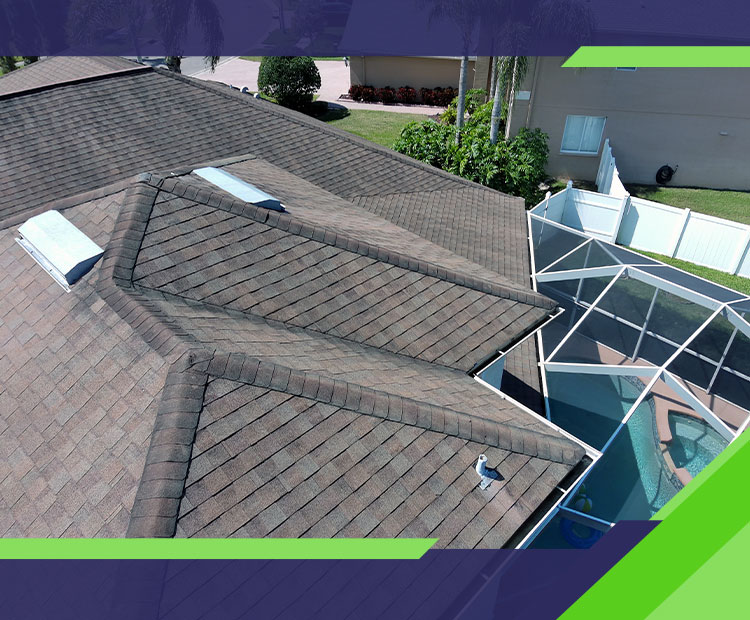Living in the Florida Panhandle comes with unique roofing challenges. Our homes face intense summer heat, high humidity, and frequent storms, all of which put stress on your roof.
Most homeowners think about shingles, leaks, or storm damage when they picture roof problems. But often, the real culprit is poor ventilation. Without proper airflow in your attic, you could be dealing with issues that affect your home’s health, your family’s comfort, and even your wallet.
In fact, roof ventilation plays a critical role in preventing mold, humidity damage, and skyrocketing energy bills.
What Is Roof Ventilation and How Does It Work?
A good ventilation system balances intake and exhaust airflow:
- Intake vents (usually at the soffits or eaves) bring fresh, cooler air into the attic.
- Exhaust vents (ridge vents, gable vents, or attic fans) let hot, moist air escape.
This continuous air cycle keeps temperatures and humidity in check, preventing damage to both the roof and the interior of your home.
Think of your roof as your home’s “breathing system.” Without airflow, your roof traps heat and moisture, leading to a chain reaction of problems that most homeowners don’t notice until it’s too late.
Problem #1: Mold and Mildew Growth
Why it’s a big deal:
Mold isn’t just ugly – it’s a health hazard. Poor ventilation lets warm, humid air get trapped in your attic, where it condenses on cooler surfaces like wood decking and insulation. Over time, this creates the perfect breeding ground for mold and mildew.
The risks of mold in your attic:
- Weakening of roof decking and rafters
- Musty odors filtering into your home
- Potential health issues like allergies and respiratory irritation
- Costly remediation bills
How ventilation helps:
- Moves moist air out before it condenses
- Keeps attic surfaces dry
- Reduces the chance of spores spreading into your home’s living areas
For homeowners in humid cities like Panama City Beach, Destin, and Navarre, this is especially critical.
Problem #2: Excess Humidity Damage
Why it’s a big deal:
Florida homes already battle high humidity year-round. When that moisture has nowhere to go, it collects in your attic – damaging insulation, warping wood, and weakening your roof from the inside out.
Signs of humidity issues in your attic:
- Rusty nails or metal fixtures
- Damp or compacted insulation
- Water stains on ceilings inside your home
- Peeling paint near the ceiling line
How ventilation helps:
- Keeps attic humidity balanced with outdoor air
- Preserves insulation effectiveness (so your home stays cooler)
- Protects against long-term structural damage
Homeowners in coastal areas like Pensacola and Fort Walton Beach see even more humidity-related issues thanks to salty, damp air that accelerates corrosion.
Problem #3: Higher Energy Bills
Why it’s a big deal:
In the summer, an under-ventilated attic can reach 150°F or hotter. That trapped heat radiates into your living space, making your AC work harder and sending your energy bills through the roof.
In the winter, poor ventilation traps warm air inside, which can cause condensation and ice damming (yes, even in North Florida on rare cold snaps).
How ventilation helps:
- Keeps attic temperatures consistent year-round
- Relieves strain on your HVAC system
- Reduces monthly utility costs
- Extends the lifespan of your air conditioning unit
If you live in Tallahassee or Marianna, where summers are brutally hot and sticky, good roof ventilation could save you hundreds each year in cooling costs.
Problem #4: Shortened Roof Lifespan
Poor ventilation doesn’t just affect your attic, it affects your roof itself. Excess heat and moisture can:
- Warp shingles so they curl or crack prematurely
- Weaken roof decking, leading to sagging or rot
- Void manufacturer warranties, since many shingle companies require proof of proper ventilation
That means you could end up replacing your roof years earlier than expected—an expense that could have been avoided.
How to Tell If Your Roof Ventilation Needs Attention
Most homeowners don’t climb into their attics regularly, so it’s easy to miss the signs of poor ventilation. Here are a few red flags:
- Your upstairs rooms are always hotter than the rest of the house
- You notice mold, mildew, or musty odors in your attic
- Your energy bills keep increasing despite no change in usage
- Shingles are curling, blistering, or showing premature wear
- You see condensation, damp insulation, or even rust in your attic
How Johnson Roofing Solutions Can Help
At Johnson Roofing Solutions, we know Florida roofs better than anyone. Serving the entire Florida Panhandle—from Pensacola to Tallahassee—we specialize in building and maintaining roofing systems designed to handle our hot, humid climate.
Our team can:
- Inspect your current roof ventilation system
- Identify hidden problems with airflow, moisture, or attic heat buildup
- Install or upgrade ventilation systems (ridge vents, soffit vents, attic fans, and more)
- Repair storm-damaged vents and prevent salt corrosion in coastal areas
We’ve helped homeowners in Pensacola, Destin, Panama City, Panama City Beach, Lynn Haven, Marianna, and Tallahassee protect their homes from mold, humidity, and high energy costs through better ventilation.
Your roof is more than shingles – it’s a system. And ventilation is one of the most important parts of that system. Without it, you risk mold, humidity damage, high energy bills, and a roof that fails years before it should.
If you’re unsure about your roof’s ventilation, don’t wait until you notice musty odors or soaring utility bills.
Contact Johnson Roofing Solutions today to schedule a professional roof inspection and learn how proper ventilation can protect your home and save you money.









